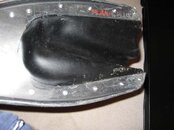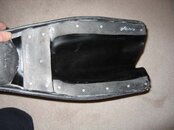I have used both a flexible sheet material of a neoprene-like material, and also a rubber-impregnated nylon fabric. It needs to be flexible, but not stretchy, if that makes sense. It also needs to start tight near the toes, and a simi-circle at the tip of the fins.Do you notice a difference in how they kick? I assume so...
Scoop design, does it frog kick well?
What material do you use for the scoop?
I used the material that I cut out of the fin as a cover material for the fabric, after cutting it into strips. I have enclosed a photo of the back side of my fins to show how I did it. I then used aluminum pop rivets to secure it, with a coating of Shoe-Goo on each underside.
It does work with a frog kick, but slightly differently. And, there is no difference if you use the top of the foot for the kick, or the sole (I've seen it both ways).
When I first started this with the Voit Viking fins (see the above blue fins with an orange interior material), the Vikings were so stiff that I could hardly kick them and bend them. With this modification they worked much better. During my U.S. Air Force career as a Pararescueman, took this design with the Avanti fins on parascuba jumps, jumps out of helicopters, and many, many dives.
They work quite well, without the huge stress on the leg muscles that stiff fins such as the Jet Fins have. Jet Fins work on the principal of having the 'jets" just below the toes, but that only (sorta) works on the downstroke. On the upstroke there is a lot of "dead area" in the middle of the fin. With the scoop design, there is much less "dead area" on the fin, as can be seen by the strings in my 1970 photos. (I cannot believe that those photos are 53 years old now, but they are!)
SeaRat
PS, it is very easy to make a set of split fins out of any flat blade without a middle rib; simply drill a hole below the toes, then use a knife (a filet knife with a thin blade works best) to cut the blade straight down the middle (along a pen or pencil line) to the end of the blade. The hole keeps the cut from traveling up the blade to the foot pocket. The split blade allows the water to flow down instead of off the side of the dead area of the blade. This produces a noticably easier stroke on the legs, and actually a more efficient water flow for the fin.
As shown above, there is an advantage of the split, but the scoop is even better as the water flow goes straight out of the blade, rather than running through the split.






